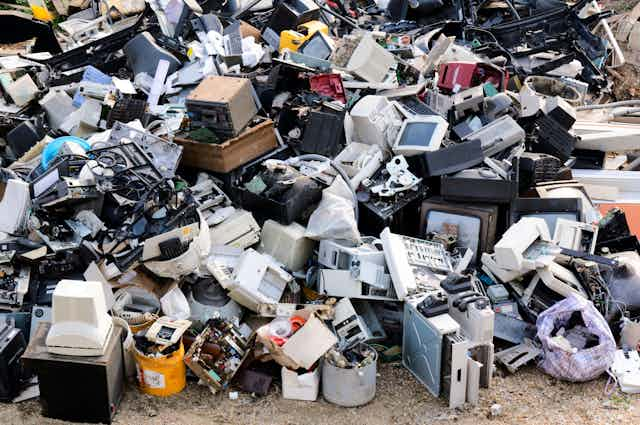A ringing phone on the peak hour train ride home may be an annoyance to be ignored, and hopefully turned to silent, but these familiar chimes are signs of a digital revolution all around us. These are the personal electronic products we engage with to help organise, connect, entertain, and inform us in an ever faster cycle.
Now they’re ubiquitous. But where do they come from, who makes them, and where do they end up when discarded? Death by Design, a documentary directed by Sue Williams screening at Environmental Film Festival Australia in Melbourne, confronts these questions.
The human cost of the digital revolution
The film begins with the development of the semiconductor industry in California, exploring the human and ecological impacts in those formative Silicon Valley years. The film shows the Silicon Valley Toxics Coalition and its successful activism to drive remediation of contamination; and the personal stories of material toxicity, and associated devastation.
Throughout the film toxicity is revisited, and the film paints a fairly bleak picture of labour rights in China. We turn to Ma Jun, the 2015 Skoll Award winner (an award for social entrepreneurship) for creating a national picture of water pollution with data that is now publicly available.
Jun laments the potential human costs across China’s water infrastructure, which begs the question: why haven’t organisations expanding to these new manufacturing regions learnt the lesson from the US industry , or applied Europe’s hazardous waste standards?
What is equally troubling are issues with even stringent auditing processes. Linda Greer, a toxicologist from the Natural Resources Defence Council put it simply: “it’s all about the questions you ask”. A firm’s audit checklist may be thorough in some respects, yet miss key points in others. As such, manufacturing may be considered adequate, yet not address the pertinent problems. Jun’s work has already resulted in supply chain actions in this regard.
Who’s to blame? All of us
The film directs us to the main driver of the large industrial expansions Jun monitors, our daily consumption habits in the west. As Lancaster University professor Elizabeth Shove has portrayed so vividly, the devices of convenience and the rituals they connect to drive consumption, both conspicuous (such as a phone) and inconspicuous (such as the energy it uses).
Consumption implicates us all, and the figures the film lists are breathtaking: from 376,000 Apple Ipod sales in 2002 to 51.6 million in 2007, and 10 million Apple Iphone 5s made in a week.
Purchases are only exacerbated by constant upgrading, and consumer inability to repair or refurbish their devices as the US firm recycling firm Ifixit explains. They’ve built a business that enables consumers to circumvent “prescribed obsolescence”, to fix their own electronic products by using their own parts, tools and how-to guides.
Irish firm iameco take this even further, challenging the notion of updatable, upgradable, and reusable computers. Both business models require the breaking down of secrecy shrouding internal access to such products.
Batteries are harder to replace now and screens harder to repair, as repairs become part of manufacturer’s business models.
As Ifixit look to disrupt that disposable model for consumers, the film follows the company to China as they source their own electronic parts, and come full circle.
With such throughput of electronics, e-waste is accepted as a major and growing issue. Darrin Magee, Environment Geographer from Hobart and Williams Smith Colleges estimates that the US generates 3 million tonnes of e-waste alone, with a much smaller amount actually repurposed and recycled. Chinese volumes of e-waste and the human cost of handling are also major problems to address.
Where to from here?
Death by Design suggests that the digital revolution has rewarded us with so many benefits, something that is reasonably clear.
Certainly with all of that success, manufacturers of electronic goods must take responsibility for how products are designed for longevity by extending life cycles, and in managing the toxic issues throughout the entire supply chain.
Part of the solution could include models that build recycling into the design such as the circular economy and cradle-to-cradle models, coupled with an increase in stewardship schemes, some of which are emerging at present.
The final sequence in the film suggests that we, the people, could use our buying power or behaviour to change the system in demands for labour safety, human health and ecological preservation. This is an interesting perspective, and could be linked to new patterns of “enlightened” consumer purchasing.
I wonder though, could it be a sharing economy opportunity? What about maker culture with new democratised technologies to help build what we need to retrofit upgrades?
Others have gone further in calling for moral outrage and collective action on related issues, such as pollution leading to climate change.
In any case, Death by Design is a thought-provoking look at an industry that we interact with every time we swipe, tap or lol. As innocuous as those actions are, substantial sustainability issues remain that we need to face as a society.
Death by Design is screening at the Environmental Film Festival Australia in Melbourne on October 6.

